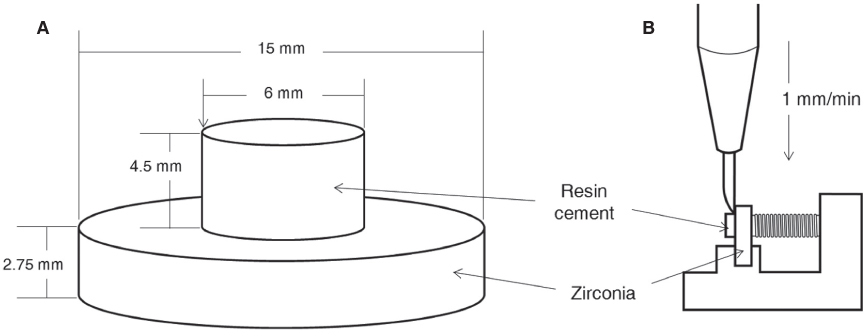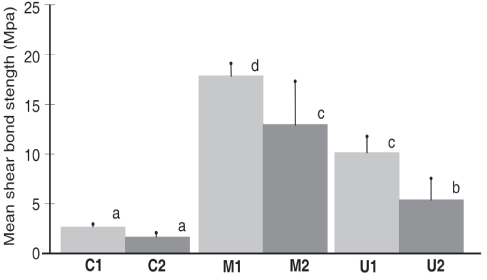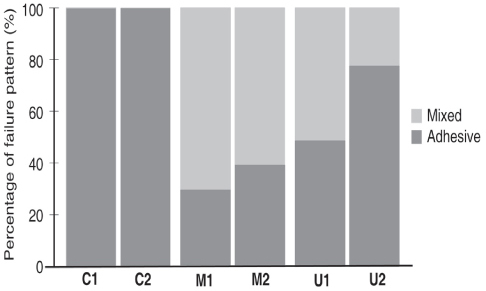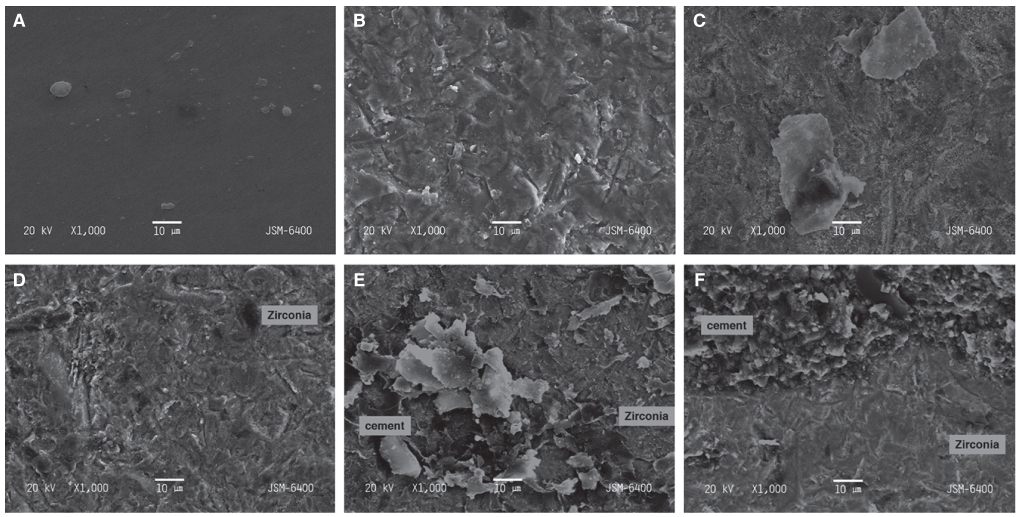J Adv Prosthodont.
2015 Feb;7(1):1-7. 10.4047/jap.2015.7.1.1.
Evaluation of shear bond strength between dual cure resin cement and zirconia ceramic after thermocycling treatment
- Affiliations
-
- 1Department of Dental Prosthodontics and Institute of Oral Bioscience, School of Dentistry, Chonbuk National University, Jeonju, Republic of Korea. jmpark@jbnu.ac.kr, jmseo@jbnu.ac.kr
- 2Research Institute of Clinical Medicine Chonbuk National University-Biomedical Research Institute of Chonbuk National University Hospital, Jeonju, Republic of Korea.
- KMID: 1974883
- DOI: http://doi.org/10.4047/jap.2015.7.1.1
Abstract
- PURPOSE
This study was performed to evaluate shear bond strength (SBS) between three dual-cured resin cements and silica coated zirconia, before and after thermocycling treatment.
MATERIALS AND METHODS
Sixty specimens were cut in 15 x 2.75 mm discs using zirconia. After air blasting of 50 microm alumina, samples were prepared by tribochemical silica coating with Rocatec(TM) plus. The specimens were divided into three groups according to the dual-cure resin cement used: (1) Calibra silane+Calibra(R), (2) Monobond S+Multilink(R) N and (3) ESPN sil+RelyX(TM) Unicem Clicker. After the resin cement was bonded to the zirconia using a Teflon mold, photopolymerization was carried out. Only 10 specimens in each group were thermocycled 6,000 times. Depending on thermocycling treatment, each group was divided into two subgroups (n=10) and SBS was measured by applying force at the speed of 1 mm/min using a universal testing machine. To find out the differences in SBS according to the types of cements and thermocycling using the SPSS, two-way ANOVA was conducted and post-hoc analysis was performed by Turkey's test.
RESULTS
In non-thermal aged groups, SBS of Multilink group (M1) was higher than that of Calibra (C1) and Unicem (U1) group (P<.05). Moreover, even after thermocycling treatment, SBS of Multilink group (M2) was higher than the other groups (C2 and U2). All three cements showed lower SBS after the thermocycling than before the treatments. But Multilink and Unicem had a significant difference (P<.05).
CONCLUSION
In this experiment, Multilink showed the highest SBS before and after thermocycling. Also, bond strengths of all three cements decreased after thermocycling.
MeSH Terms
Figure
Cited by 1 articles
-
Change of phase transformation and bond strength of Y-TZP with various hydrofluoric acid etching
Mi-Kyung Yu, Eun-Jin Oh, Myung-Jin Lim, Kwang-Won Lee
Restor Dent Endod. 2021;46(4):e54. doi: 10.5395/rde.2021.46.e54.
Reference
-
1. Odén A, Andersson M, Krystek-Ondracek I, Magnusson D. Five-year clinical evaluation of Procera AllCeram crowns. J Prosthet Dent. 1998; 80:450–456.2. Kern M, Wegner SM. Bonding to zirconia ceramic: adhesion methods and their durability. Dent Mater. 1998; 14:64–71.3. Kosmac T, Oblak C, Jevnikar P, Funduk N, Marion L. The effect of surface grinding and sandblasting on flexural strength and reliability of Y-TZP zirconia ceramic. Dent Mater. 1999; 15:426–433.4. Borges GA, Sophr AM, de Goes MF, Sobrinho LC, Chan DC. Effect of etching and airborne particle abrasion on the microstructure of different dental ceramics. J Prosthet Dent. 2003; 89:479–488.5. Luthardt RG, Holzhüter M, Sandkuhl O, Herold V, Schnapp JD, Kuhlisch E, Walter M. Reliability and properties of ground Y-TZP-zirconia ceramics. J Dent Res. 2002; 81:487–491.6. Luthardt R, Weber A, Rudolph H, Schöne C, Quaas S, Walter M. Design and production of dental prosthetic restorations: basic research on dental CAD/CAM technology. Int J Comput Dent. 2002; 5:165–176.7. Brentel AS, Ozcan M, Valandro LF, Alarça LG, Amaral R, Bottino MA. Microtensile bond strength of a resin cement to feldpathic ceramic after different etching and silanization regimens in dry and aged conditions. Dent Mater. 2007; 23:1323–1331.8. Krämer N, Frankenberger R. Clinical performance of bonded leucite-reinforced glass ceramic inlays and onlays after eight years. Dent Mater. 2005; 21:262–271.9. Ozcan M, Vallittu PK. Effect of surface conditioning methods on the bond strength of luting cement to ceramics. Dent Mater. 2003; 19:725–731.10. Blatz MB, Sadan A, Kern M. Resin-ceramic bonding: a review of the literature. J Prosthet Dent. 2003; 89:268–274.11. Dérand P, Dérand T. Bond strength of luting cements to zirconium oxide ceramics. Int J Prosthodont. 2000; 13:131–135.12. Mirmohammadi H, Aboushelib MN, Salameh Z, Feilzer AJ, Kleverlaan CJ. Innovations in bonding to zirconia based ceramics: Part III. Phosphate monomer resin cements. Dent Mater. 2010; 26:786–792.13. Parsa RZ, Goldstein GR, Barrack GM, LeGeros RZ. An in vitro comparison of tensile bond strengths of noble and base metal alloys to enamel. J Prosthet Dent. 2003; 90:175–183.14. Kim CH, Jeon YC, Jeong CM, Lim JS. Effect of surface treatments of zirconia ceramic on the bond strength of resin cements. J Korean Acad Prosthodont. 2004; 42:386–396.15. Tsuo Y, Yoshida K, Atsuta M. Effects of alumina-blasting and adhesive primers on bonding between resin luting agent and zirconia ceramics. Dent Mater J. 2006; 25:669–674.16. Kulunk S, Kulunk T, Ural C, Kurt M, Baba S. Effect of air abrasion particles on the bond strength of adhesive resin cement to zirconia core. Acta Odontol Scand. 2011; 69:88–94.17. Phark JH, Duarte S Jr, Blatz M, Sadan A. An in vitro evaluation of the long-term resin bond to a new densely sintered high-purity zirconium-oxide ceramic surface. J Prosthet Dent. 2009; 101:29–38.18. Karakoca S, Yilmaz H. Influence of surface treatments on surface roughness, phase transformation, and biaxial flexural strength of Y-TZP ceramics. J Biomed Mater Res B Appl Biomater. 2009; 91:930–937.19. Wegner SM, Gerdes W, Kern M. Effect of different artificial aging conditions on ceramic-composite bond strength. Int J Prosthodont. 2002; 15:267–272.20. Ozcan M. The use of chairside silica coating for different dental applications: a clinical report. J Prosthet Dent. 2002; 87:469–472.21. Amaral R, Ozcan M, Bottino MA, Valandro LF. Microtensile bond strength of a resin cement to glass infiltrated zirconia-reinforced ceramic: the effect of surface conditioning. Dent Mater. 2006; 22:283–290.22. Ozcan M, Nijhuis H, Valandro LF. Effect of various surface conditioning methods on the adhesion of dual-cure resin cement with MDP functional monomer to zirconia after thermal aging. Dent Mater J. 2008; 27:99–104.23. Isidor F, Stokholm R, Ravnholt G. Tensile bond strength of resin luting cement to glass infiltrated porous aluminium oxide cores (In-Ceram). Eur J Prosthodont Restor Dent. 1995; 3:199–202.24. Söderholm KJ, Shang SW. Molecular orientation of silane at the surface of colloidal silica. J Dent Res. 1993; 72:1050–1054.25. D'Amario M, Campidoglio M, Morresi AL, Luciani L, Marchetti E, Baldi M. Effect of thermocycling on the bond strength between dual-cured resin cements and zirconium-oxide ceramics. J Oral Sci. 2010; 52:425–430.
- Full Text Links
- Actions
-
Cited
- CITED
-
- Close
- Share
- Similar articles
-
- Influence of nano-structured alumina coating treatment on shear bond strength between zirconia ceramic and resin cement
- The effect of surface treatment conditioning on shear bond strength between zirconia and dental resin cements
- Shear Bonding Strength of Three Cements Luted on Pediatric Zirconia Crowns and Dentin of Primary Teeth
- Effect of surface treatments of zirconia ceramic on the bond strength of resin cements
- Shear bond strength of the three different kinds of resin cement on CAD/CAM ceramic inlay





